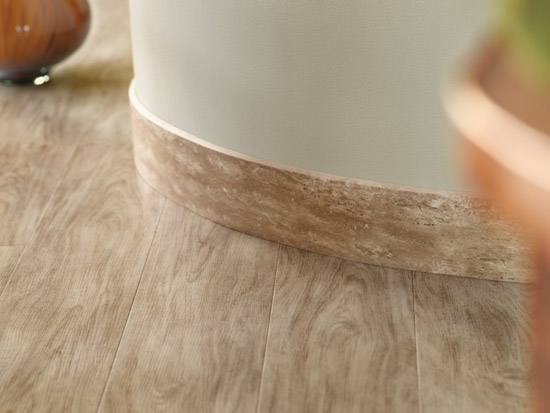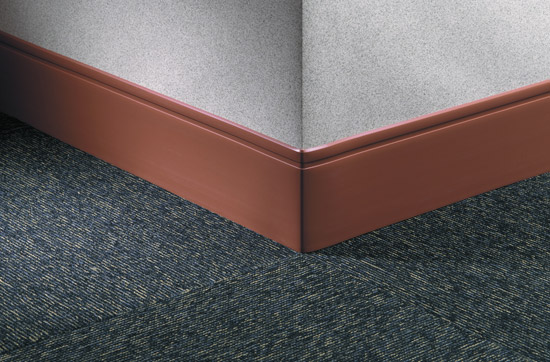New Sustainable and Aesthetic Options in Finishing Borders (Wall Base)
Performance Considerations
Wall base adds an important finishing touch to a space, making it feel and look complete. Selecting a wall base that will maintain its aesthetic appeal with minimal maintenance is a typical performance objective. However, not every wall base material is capable of being a virtually maintenance-free, aesthetically uncompromised wall base over time. Wood naturally swells and shrinks in response to changes in temperature and humidity. This shape shifting often causes a wood wall base to separate from the wall. It can also cause the paint coating on the wood to chip, crack and peel and require that the wall base be repainted to restore the aesthetic appeal. In terms of withstanding wear and tear, wood may be one of the least durable wall base materials available, as ordinary use may create dents and dings in the physical wood. Once the physical wood is damaged, it may need to be replaced, instead of repainted, to restore the aesthetic. Carpet can fray over time and keeping the fabric clean and stain-free can present more of a maintenance challenge than may have been considered when the material was initially specified.
Good fit is another important objective of a wall base. Stainless steel is very low maintenance, and very durable, but the material itself is not very forgiving and this can limit the ability of a stainless steel wall base to adapt to any inconsistencies that may exist in the built space and may compromise the overall fit that it may provide once installed.
Resilient wall base, made of rubber or vinyl, is a low maintenance wall base that resists scuffing, fading and cracking. It addition to its impressive durability, resilient wall base will not shrink or separate from the wall. Traditional resilient wall base is not painted, so it will never need to be repainted, and it is a surface that is easy to clean and disinfect. It is also more flexible and forgiving than other materials, so it can easily accommodate imperfections in the built environment and it is just as easily installed along a straight wall or a circular column.
 |
Resilient wall base is flexible and easily wraps around circular columns. Photo courtesy of Tarkett |
Style
A common question designers have about wall base products relates to the difference between the styles. In the world of wall base, there are many names for essentially two styles. One style of wall base is referred to as flat, straight, or toeless. This straight or toeless style of wall base runs straight from the top of the wall base to the bottom, without any type of sculptured or indentation detail. This style of wall base is best suited to applications with carpet. The other style of wall base is often called toe or cove. This wall base style, as the name may indicate, has a toe at the bottom of the wall base that curves outward to cover the gap. The toe or cove wall base style is best matched to vinyl, rubber, wood or tile floors.
 |
While flat wall base runs straight to the floor, wall base with toe curves outward at the bottom of the border. Photo courtesy of Tarkett |
Size
Across the industry, wall base is typically available in three standard heights and two thicknesses. The three standard heights are 2.5” (6.4cm), 4.0” (10.2cm), 6.0” (15.3cm). Selecting the height of a wall base is, in many applications, almost an exclusively aesthetic decision. One exception is healthcare institutions, where many designers prefer to specify wall base that is 6.0” or higher to offer a greater degree of wall protection.
The two thicknesses are 1/8-inch (3.2mm) and 0.080-inch (2.0mm). The 1/8-inch thickness offers better coverage for camouflaging wall inconsistencies. The 0.080” thickness is a value option, which usually has a lower material cost, but doesn’t cover issues in the built environment well. The thinner wall base is often found in tenant improvement situations where cost is the primary consideration.
Cost
While product costs vary from manufacturer to manufacturer, generally speaking, stainless steel wall base is the most expensive. Wood and carpet wall base are less expensive than stainless steel, while resilient wall bases, made from rubber and vinyl, are often the least expensive of the bunch.









